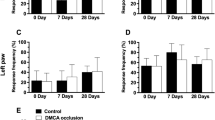Rats with a model of ischemic stroke in the sensorimotor zone of the cortex induced by removal of a fragment of the meninges with their superficial vessels were used to study the effects of the location of focal ischemia in the left and right hemispheres on the severity of neurological deficit. Preliminary testing for food grasping with the forelimb was used to identify the dominant hemisphere, i.e., right-handed and left-handed rats. The functions of the forelimbs were monitored daily for eight weeks in a cylinder test, and a whiskers test and swimming test were also performed. There were no differences in measures on these tests in rats with strokes in the right and left hemispheres throughout the study. In rats with lesions in the dominant hemisphere, recovery of forelimb functions was significantly better than in those with lesions in the non-dominant hemisphere. The link between brain lateralization in rats and the level of recovery of motor function should be taken into account when planning the design of preclinical studies of new agents for the treatment of stroke.
Similar content being viewed by others

References
V. F. Fokin, I. N. Bogolepova, B. Gutnik, et al., Handbook in Functional Interhemisphere Asymmetry [in Russian], Nauchnyi Mir, Moscow (2009).
M. C. Corballis, “The evolution and genetics of cerebral asymmetry,” Phil. Trans. Roy. Soc. Lond. B. Biol. Sci., 364, No. 1519, 867–879 (2009).
G. Vallortigara and L. J. Rogers, “Survival with an asymmetric brain: advantages and disadvantages of cerebral lateralization,” Behav. Brain Sci., 28, No. 4, 575–589; Discussion 589–633 (2005).
T. A. Dobrokhotova (ed.), N. N. Bragina, and K. K. Karmenyan, in: Neuropsychiatry [in Russian], Binom, Moscow (2006), No. 2–3, pp. 26–82.
I. Belcheva, R. Tashev, S. Belcheva, “Hippocampal asymmetry in serotoninergic modulation of learning and memory in rats,” Laterality, 12, No. 6, 475–486 (2007).
M. Ivanova, A. Ternianov, S. Belcheva, et al., “Hippocampal asymmetry in exploratory behavior to vasoactive intestinal polypeptide,” Peptides, 29, No. 6, 940–947 (2008).
B. Kolb, C. Morshead, C. Gonzalez, et al., “Growth factor-stimulated generation of new cortical tissue and functional recovery after stroke damage to the motor cortex of rats,” J. Cereb. Blood Flow Metab., 27, No. 5, 983–997 (2007).
S. C. Wolff, Z. Hruska, L. Nguyen, and G. P. Dohanich, “Asymmetrical distributions of muscarinic receptor binding in the hippocampus of female rats,” Eur. J. Pharmacol., 588, No. 2–3, 248–250 (2008).
H. Gao and M. Zhang, “Asymmetry in the brain influenced the neurological deficits and infarction volume following the middle cerebral artery occlusion in rats,” Behav. Brain Funct., 4, 57 (2008).
C. Betaneur, P. J. Neveu, and M. Le Moal, “Strain and sex differences in the degree of paw preference in mice,” Behav. Brain Res., 45, 97–101 (1991).
C. L. Gonzalez and B. Kolb, “A comparison of different models of stroke on behaviour and brain morphology,” Eur. J. Neurosci., 18, 1950–1962 (2003).
B. Kolb, S. Cote, A. Ribeiro-da-Silva, and A. C. Cuello, “Nerve growth factor treatment prevents dendritic atrophy and promotes recovery of function after cortical injury,” Neurosci., 76, 1139–1151 (1997).
A. A. Dunn-Meynell and B. E. Levin, “Lateralized effect of unilateral somatosensory cortex contusion on behavior and cortical reorganization,” Brain Res., 675, No. 1–2, 143–156 (1995).
H. Shen and Y. Wang, “Correlation of locomotor activity and brain infarction in rats with transient focal ischemia,” J. Neurosci. Meth., 186, No. 2, 150–154 (2010).
I. Q. Wishaw, D. M. Piecharka, F. Zeeb, and D. G. Stein, “Unilateral frontal lobe contusion and forelimb function: chronic quantitative and qualitative impairments in reflexive and skilled forelimb movements in rats,” J. Neurotrauma, 21, No. 11, 1584–1600 (2004).
F. Aggestam and P. M. Cahusac, “Behavioural lateralization of tactile performance in the rat,” Physiol. Behav., 91, No. 2–3, 335–339 (2007).
D. D. Elalmis, K. T. Ozgünen, S. Binokay, et al., “Differential contributions of right and left brains to paw skill in right- and left-pawed female rats,” Int. J. Neurosci., 113, No. 8, 1023–1042 (2003).
M. Grabowski, C. Nordborg, and B. B. Johansson, “Sensorimotor performance and rotation correlate to lesion size in right but not left hemisphere brain infarcts in the spontaneously hypertensive rat,” Brain Res., 547, No. 2, 249–257 (1991).
R. G. Robinson, “Differential behavioral and biochemical effects of right and left hemispheric cerebral infarction in rat,” Science, 205, 707–710 (1979).
N. Kutlu, H. S. Vatansever, T. O. Bayazit, et al., “Blood brain barrier in right-and left-pawed female rats assessed by a new staining method,” Int. J. Neurosci., 112, No. 9, 1037–1046 (2002).
I. S. Stashkevich, “Formation and organization of motor preference in rats,” in: Handbook in Functional Interhemisphere Asymmetry [in Russian], V. F. Fokin, I. N. Bogolepov, B. Gutnik, V. I. Kobrin, and V. V. Shulgovskii (eds.), Nauchnyi Mir, Moscow (2009), pp. 124–145.
Author information
Authors and Affiliations
Corresponding author
Additional information
Translated from Zhurnal Nevrologii i Psikhiatrii imeni S. S. Korsakova (Stroke), Vol. 110, No. 9, Iss. 2, pp. 57–62, September, 2010.
Rights and permissions
About this article
Cite this article
Volkov, A.I., Lebedev, S.V., Starykh, E.P. et al. Post-Stroke Neurological Impairments in Rats with Functional Asymmetry of the Cerebral Hemispheres. Neurosci Behav Physi 41, 865–870 (2011). https://doi.org/10.1007/s11055-011-9500-z
Published:
Issue Date:
DOI: https://doi.org/10.1007/s11055-011-9500-z


